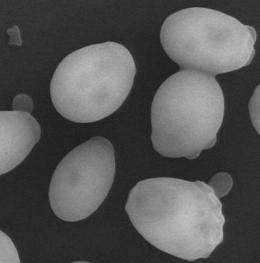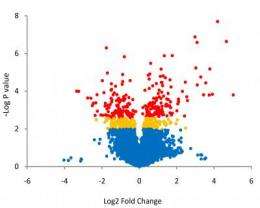New hope in fight against Huntington's disease

Hope for new ways of treating devastating neurodegenerative disorders such as Huntington's disease has been raised by a trans-Atlantic team of researchers thanks to the use of cutting-edge genetic techniques.
Led by the University of Leicester, scientists from the University of Lisbon (led by Dr Tiago Outeiro) and University of California at San Francisco (led by Dr Paul Muchowski) collaborated to generate novel approaches for tackling the diseases. Their work, funded by the Medical Research Council, is published in The Journal of Biological Chemistry.
At Leicester, working simply with baker's yeast, a team of biological scientists examined aspects of Huntington's disease. These yeast are extremely well-characterised and have powerful and facile genetics which allow researchers to rapidly interrogate this system at a genome-wide level. Research in recent years has found that baker's yeast can be used to study mechanisms underlying disease pathology, and this simple organism has been used to identify several promising candidate drug targets for neurodegenerative disorders, including Huntington's disease.
Flaviano Giorgini, lead author of the research paper at the University of Leicester, said: "My research group is interested in using genetics and genomics approaches to better understand the fatal neurodegenerative disorders of Huntington's disease and Parkinson's disease.
"By clarifying the genes and cellular pathways involved in these diseases we hope to identify novel strategies for treatment and therapy of these disorders. In our work we use simple, yet powerful genetic organisms such as baker's yeast and fruit flies to model aspects of these devastating diseases.

"In the current study we have used a novel functional genomics profiling approach to identify genes which can protect these simple organisms from disease symptoms. We then used computational approaches to uncover a network of interactions amongst these genes, which has shed light on the mechanisms underlying this disorder."
Using the approach above, the scientists found that many of the protective genes are involved in translation – a cellular process in which messenger RNA (mRNA) is decoded by the ribosome to produce specific proteins. This is particularly intriguing as this process has not been implicated in Huntington's disease in the past.
This is important because recent work indicates that pharmacological modulation of translation may represent a promising avenue for treatment of Parkinson's disease. Therefore, this new research strongly dovetails with these observations and suggests that similar drug treatment may be beneficial in Huntington's disease.
Dr Giorgini, of the Department of Genetics, said: "Our research has taken advantage of cutting edge genomics approaches using a simple model organism to identify a novel area for potential therapeutic intervention for Huntington's disease.
"If our findings are validated by further studies, it might suggest a novel therapeutic approach for this devastating disorder - which is critical as currently there are no treatments for onset or progression of symptoms."
More information: Functional Gene Expression Profiling in Yeast Implicates Translational Dysfunction in Mutant Huntington Toxicity, The Journal of Biological Chemistry, Vol. 286, Issue 1, 410-419, JANUARY 7, 2011. DOI:10.1074/jbc.M110.101527
Provided by University of Leicester














